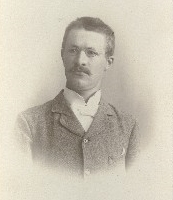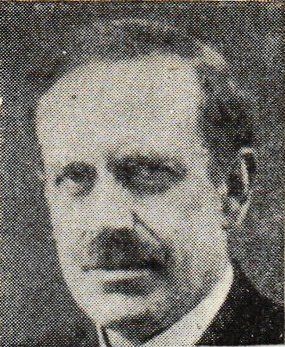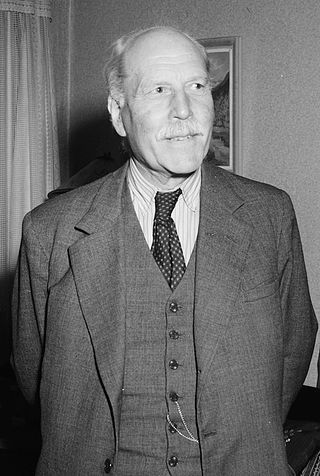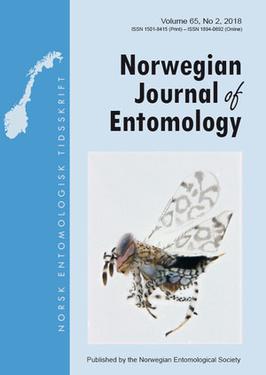Related Research Articles

Embrik Strand was an entomologist and arachnologist who classified many insect and spider species, including the greenbottle blue tarantula.

Robert Collett was a Norwegian zoologist. Collett was director and curator of the Zoological Museum at University of Oslo.
Astrid Løken was a Norwegian entomologist and member of the Norwegian resistance movement during World War II. Spending most of her career at Bergen Museum, from 1949 to 1979, she was the first female member of the Norwegian Entomological Society, and specialized in the bumblebee genus Bombus.
Leif Randulff Ryvarden is a Norwegian mycologist.

Jacob Liv Borch Sverdrup was a Norwegian educator and farmer, known for establishing the first agricultural school in Scandinavia.

Atylotus rusticus is a species of horse-flies in the genus Atylotus. It is found in Europe, Asia and North Africa.

Ole Andreas Krogness was a Norwegian physicist. He worked for the establishment of a geophysical institute in Tromsø, and served as the institute's manager from 1918 to 1922. He was instrumental in many geophysical accomplishments in northern Norway in the early 20th century.
Einar Hoffstad was a Norwegian encyclopedist, newspaper editor, writer and economist. He remains best known as the editor of the encyclopedia Merkantilt biografisk leksikon and the business periodical Farmand. Although initially a classic liberal, Hoffstad embraced fascism and collectivism at the beginning of the Second World War.

Hjalmar Broch was a Norwegian zoologist and university professor at the University of Oslo (1937–1952). His specialty was biology of lesser marine animals; he published extensively on the biology of fish.
Arne Semb-Johansson was a Norwegian zoologist. He was born in Kristiania. He chaired the Norwegian Entomological Society from 1950 to 1953. He was assigned as a professor of zoology at the University of Oslo from 1959. Among his early works were studies of the nervous system and endocrine system of insects. He edited the six volume encyclopedia Cappelens Dyreleksikon, published 1979–1981. He was decorated Knight, First Class of the Order of St. Olav in 1987.
Ragnhild Andrine Sundby was a Norwegian zoologist who specialized in entomology. She was the first female professor at the Norwegian College of Agriculture.

Thor Hiorth Schøyen was a Norwegian entomologist.

Wilhelm Maribo Schøyen was a Norwegian entomologist. He was Norway's first government entomologist.
Thomas Georg Münster was a mine manager. He was also a diligent entomologist with a particular interest in beetles.

The Norwegian Journal of Entomology is a biannual peer-reviewed scientific journal covering entomology, and arthropodology more in general, with an emphasis on Norway. It was established in 1920 as the Norsk Entomologisk Tidsskrift, obtaining its current title in 1974. From 1979 to 1998 it was published under the name Fauna Norvegica Serie B. The journal is published by the Norwegian Entomological Society and the editor-in-chief is Øivind Gammelmo.
Karl Harald Adolf Haanshus was a Norwegian physician and entomologist. He joined the Norwegian Entomological Society in 1915. He was its vice chairman from 1933 to 1935, and he was also a member of the editorial committee of the Norwegian Journal of Entomology.
Leif Reinhardt Natvig was a Norwegian entomologist. He was employed throughout his entire career at the Oslo Zoological Museum, and he contributed to a stronger connection between the museum and the Norwegian Entomological Society.
Ejnar Fischer was a Norwegian engineer and entomologist. He especially collected beetles, many from his time spent in Australia. He was one of the founders of the Norwegian Entomological Society, which was established in 1904.
Andreas Strand was a Norwegian entomologist that specialized in Nordic beetles. Strand became a member of the Norwegian Entomological Society in 1920, and he is one of the leading figures in Norwegian entomology. His professional career included work as an administrator, secretary, vice chairman, and accountant.
Lauritz Sverdrup Sømme is a Norwegian entomologist. His work has focused on insects in houses and stored foods, and especially the wintering and cold tolerance of certain arthropods. Sømme has been on several expeditions to the Antarctic, participated in field trips to Svalbard, and visited various other extreme places on Earth in his research on arthropods and cold tolerance.
References
- 1 2 "Norsk entomologisk forening". Store norske leksikon. 2018. Retrieved September 24, 2019.
- ↑ "Norwegian Entomological Society" . Retrieved September 24, 2019.
- 1 2 "Om NEF". Norsk entomologisk forening. Retrieved September 25, 2019.
- ↑ "Thomas Georg Münster". Store norske leksikon. 2009. Retrieved September 25, 2019.
- ↑ Sømme, Lauritz (2004). Entomologiens historie i Norge. Norsk entomologisk forening 1904–2004. Oslo: Zoologisk museum, Universitetet i Oslo. p. 95.
- ↑ Hågvar, Sigmund (1999). "Arne Semb-Johansson intervjuet av Sigmund Hågvar 6. november 1997". Insekt-Nytt. 24 (4): 22. Retrieved September 26, 2019.
- ↑ Dahl, Knut; Lid, Johannes; Münster, Thomas (1924). "A Division of Norway into Bio-Geographical Sectional Areas Agreed Upon by Botanists and Zoologists". Skrifter utgitt av Videnskapsselskapet i Kristiania I, Matematisk-naturvidenskabelig Klasse (7).
- ↑ "Regionsinndeling til bruk ved kartlegging av Norges insektsliv". Naturhistorisk museum. Retrieved September 28, 2019.
- ↑ Hansen, Lars Ove; Aarvik, Leif (2000). Sjeldne insekter i Norge 3. Sommerfugler (Lepidoptera) (PDF). Oslo: NINA, Norsk institutt for naturforskning. p. 10. ISBN 82-426-1115-7 . Retrieved September 28, 2019.
- ↑ "Artsobservasjoner har nådd 20 millioner funn". Artsdatabanken. January 11, 2019. Retrieved September 29, 2019.
- ↑ "Norwegian Journal of Entomology". Norsk entomologisk forening. Retrieved September 30, 2019.